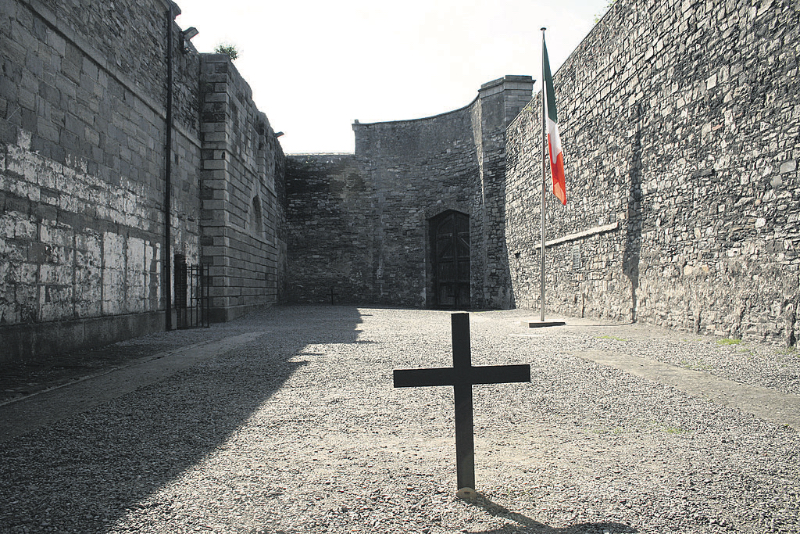IN the aftermath of the 1916 Rising, many of its leaders and participants were put on trial before a British Military Court Martial and 16 men were subsequently executed in the Stonebreakers’ Yard, Kilmainham Gaol. This article gives a brief biography of the first seven leaders to be executed.
May 3
Among the first to be executed was Padraig Pearse, President of the Provisional Government of the Irish Republic and viewed by many to be the embodiment of the revolution.
Pearse was a poet and writer, a teacher, a barrister, and an Irish language activist who established a radical bi-lingual school at St Enda’s in Rathfarnham. He was an important member of the IRB and a founding member and Director of Operations of the Irish Volunteers.
During the 1916 Rising Pearse was the Commander in Chief of the Republican Army, reading the 1916 Proclamation outside the GPO.
Next before the firing squad was Tom Clarke, the veteran Fenian, who had been giving the honour of signing the Proclamation first by his comrades, as a mark of respect to the earlier generations of Irish revolutionaries.
Clarke represented the living continuity of the republican struggle. A veteran of the Fenian dynamite campaign in Britain, Clarke had been imprisoned and exiled in America before returning to Ireland to reorganise the IRB.
Clarke was arguably the key architect and one of three driving forces behind the 1916 Rising. During Easter Week, Clarke took no formal military rank or title, but was one of the key leaders at the republican garrison in the GPO.
Also executed on May 3, was Thomas MacDonagh. Before the Rising MacDonagh had won acclaim as a poet and a playwright with some of his works being performed at the Abbey Theatre.
A serious Irish language activist, MacDonagh was the vice principal of Pearse’s St Enda’s School, while also lecturing in English at University College Dublin. A founding member of the Irish Volunteers, MacDonagh was appointed to its provisional committee, but did not become a member of the IRB until 1915. MacDonagh was appointed to the Military Council in April 1916 and during the 1916 Rising served as Commandant of the 2nd Battalion of the Dublin Brigade, which occupied Jacob’s Biscuit Factory.
May 4
Joseph Mary Plunkett was the next signatory of the Proclamation to be executed. Plunkett was a founding member of the Irish Volunteers and a member of its provisional committee.
Plunkett was also a member of the IRB and in 1915 was sent on a secret mission to Germany to check on the progress of Roger Casement’s negotiations with the Imperial Government.
Plunkett was an early member of the Military Council and played a key role in drafting the military plans for the Rising. Plunkett is perhaps best known for his marriage to Grace Gifford, just hours before his execution in Kilmainham Gaol.
Edward Daly, a brother-in-law of Tom Clarke, was a key member of the IRB and Irish Volunteers in the lead up to the Rising. As Commandant of the 1st Battalion of the Dublin Brigade, Daly was in command of the Republican Garrison at the Four Courts. Daly was a natural solider and leader, and this was recognised by the English officers who took his surrender, who allowed Daly to lead his troops out and parade with arms as a sign of respect.
Michael O’Hanrahan, was Quarter Master General of the 2nd Battalion of the Dublin Brigade and one of the key leaders of the Republican Garrison at Jacobs.
A lifelong republican, O’Hanrahan was a prominent figure in the Gaelic League as well as a well-known nationalist journalist, writing under the pen names ‘Art’ and ‘Irish Reader’ in several republican publications. O’Hanrahan was a member of the IRB and a founding member of the Volunteers and was employed as an administrator at Volunteer headquarters before the Rising.
May 4 also saw the execution of Willie Pearse, the younger brother of Padraig. A talented artist and sculptor, Willie’s work can still be seen in many churches around Ireland.
Before the Rising, Willie Pearse was a prominent republican serving as a member of the executive committee of the Wolfe Tone Memorial Committee, an important front organisation of the IRB.
A founding member of the Irish Volunteers during the 1916 Rising, Willie served as a captain in the Republican headquarters in the GPO.
Daithi O Riain
